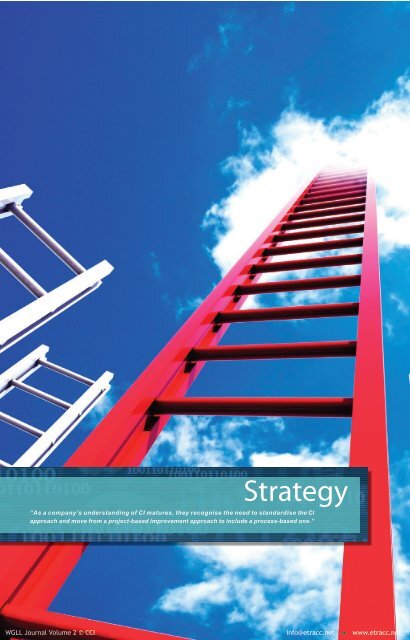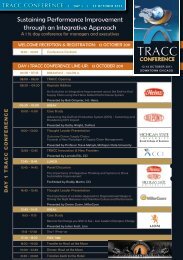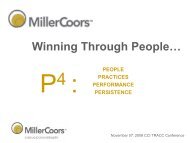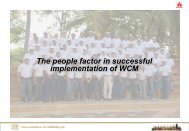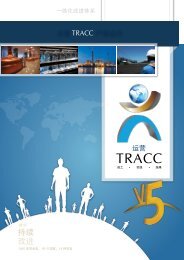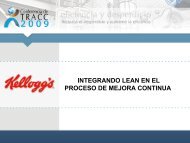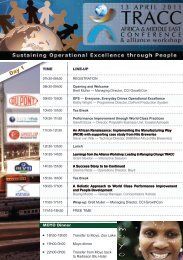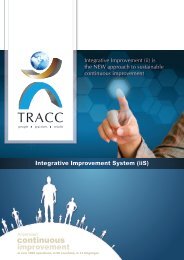Strategy - TRACC
Strategy - TRACC
Strategy - TRACC
- No tags were found...
You also want an ePaper? Increase the reach of your titles
YUMPU automatically turns print PDFs into web optimized ePapers that Google loves.
<strong>Strategy</strong> - LEAPFROG YOUR WAY TO WORLD CLASSjourney have been considered ‘successful’(depending on objectives, scope, andcriteria), most such journeys have notbeen sustainable.Sustainable transformation requiresengagement at all levels as well as amanagement system that addressesthe long-term, incremental nature ofculture-based change.If we know what features have evolvedin world class companies’ managementsystems, and we introduce these in anintegrative system that companies new onthe journey can use, it will enable themto leapfrog many years of implementationexperience. Thus they would generateexponential savings and competitiveadvantage much sooner than companies seeking to develop this in-house.Modern management principlesThere have been two paradigm shifts in operations management thinking since theIndustrial Revolution. Both have been well documented and have advanced organisationalmanagement; and each was exemplified by two major automotive companies: Fordand Toyota.Henry Ford was responsible for the first big shift. His famous offer of “You can have anycolour, as long as it’s black” encapsulates a broad range of initiatives to standardise andreduce automobile manufacturing complexities. Such standardisation allowed themanufacturing and assembly process to be divided into a number of small tasks for relativelyunskilled workers. Thus, quality was drastically improved while costs were reduced. Thestandardisation process was also applied to management tasks to create the functionalorganisation we still use today.While this was a great step forward from the craft archetype used prior to Henry Ford’stime, this model still contained inherent inefficiencies. It assumes that only managersand technical experts can add value. It also relies on a top-down management style withprocess improvements only in functions. In this model, the role of operations is thusreduced to managing cost.After World War II, another paradigmshift emerged in Japan. However,it was only recognised in the Westfrom the early 1980s. The firstcomprehensive documentation ofthis new management model waspublished in 1990: Womack andJones’ The Machine that Changedthe World. This work described the“Successful Lean implementation requires arobust management system. Such a systemrequires three key structural components toeffectively drive the transformation process:maturity-based transformation, functionalintegration, and sustainability through athree-tiered system.”management systems used by top-performing auto companies, especially Toyota, in astudy that compared performance figures and processes in multiple sites across the globe.This model’s premise is that all employees must add value; the organisation must bedesigned around processes, value streams, products, and customers – as opposed tofunctions. There must therefore be a fundamental shift if we are to effectively lead andmanage people so as to bring about the required transformation. In this model, the roleof operations thus moves from cost management to exploiting operations as the ultimatesource of competitive advantage.Essential structural components of a management systemDespite many books, articles and white papers on the advantages of the managementsystem called Lean Manufacturing, companies have not seen sustained success as a resultof adopting this model. The few companies that have experienced success have typicallyundergone long-lasting and significant organisational transformation so as to make thismodel sustainable.Successful Lean implementation requires a robust management system. Such a systemrequires three key structural components to effectively drive the transformation process:WGLL Journal Volume 2 © CCI info@etracc.net www.etracc.net
LEAPFROG YOUR WAY TO WORLD CLASS - <strong>Strategy</strong>maturity-based transformation, functional integration,and sustainability through a three-tiered system.Component 1: Maturity-based transformationThere is no quick-fix approach to changing anorganisation’s culture. Engaging all employees,developing their skills and competencies to effectprocess improvements, and the fundamental shiftin leadership style from ‘cop to coach’, take effortand time.Transferring process improvement ownership fromtechnical experts to front-line workers requiresstructural reorganisation around lateral processes.Employee skills and knowledge must also be built.Employees must be motivated to remove all obstacles(including traditional management’s tendency to solveproblems on behalf of employees). We can only holdemployees accountable as they become competent inevery new work element.A maturity-based management system needsa three to five year execution road map and mustmeasure exactly where a particular site or process areais on this journey. Appropriate implementation actionsare determined by the evolving maturity of the processarea and process-based team, ensuring consistencyin the long-term execution plan required by culturebasedchange.Component 2: Functional integrationOne of the key principles of the new managementmodel is that the organisation should be designedaround processes, products and customers.Multifunctional teams optimise processes and valuestreams to deliver superior products to ‘delighted’customers.This management system must drive this process-basedapproach and prevent possible sub-optimisation of functional improvement approaches.This means that the functional improvement requirements (quality, maintenance, planning,HR, etc) as well as all the continuous improvement methodologies (Lean, Six Sigma, TPM,TQM, WCM, etc.) are on the same platform and are executed simultaneously.Component 3: Sustainability through a three-tiered systemSustainable improvement does not result from the mere application of continuousimprovement tools. The introduction of autonomous maintenance checks, one-pointlessons, five why problem-solving forms, visual management boards, and so on are notsustainable without supporting systems and underpinning management principles.Sustainable change requires a three-tiered system; these three tiers are the managementprinciples, systems, and tools.An example in the quality function illustrates the three tiers:1.2.3.A fundamental principle of the modern quality management approach is: “Ensuringgood quality by controlling it at the source: in the process, by the operator, and atthe supplier.”The quality system will document the training plans, audit procedures, SOPs, qualityplans, critical control points, etc. to help ensure that control approach, measures, andprocedures have been formulated and are available.The operators will use tools such as run charts and SPC charts to ensure processesremain under control.An effective quality management system requires that the principles, systems, and tools bein place. This is true for all our functional systems.A complete management system requires that the management principles, systemsand tools are ready in all functions to ensure implementation sustainability, that thetransformation process be managed effectively according to a maturity-based system,WGLL Journal Volume 2 © CCI info@etracc.net www.etracc.net
LEAPFROG YOUR WAY TO WORLD CLASS - <strong>Strategy</strong>no shared framework that allows for either the understanding or the benchmarking ofsuch systems.Benchmarking your improvement systemGlobal organisations intent on engaging employees and implementing currentoperations philosophies must evaluate their current continuous improvementmethodology, and must be aware of gaps that may result in failed implementation,as well as between different implementations. Companies that have undergone manyinitiatives will have experienced failure at some level.What then do we need to build into our management systems to enable us to successfullyand sustainably execute the long-term transformation process?Figure 1 depicts five stages of evolution in CI systems. Typically, successful world classcompanies have evolved through these stages as they have experimented with CI. If werecognise that companies that have been successful in finding the holy grail of culturebasedCI have done so through their management systems, we need to understand thesemanagement systems’ critical features.A question for companies starting this journey is: Can we get a head start in this longjourney if we build these features and structural components into our managementsystems from the outset?The paper is based on the premise that the long-term nature of the transformation requires asystemic approach to managing such change. Aspects within the system are listed below:• <strong>Strategy</strong>Is the end state vision clear? What will the new work organisation, determined bythe adopted management principles, look like? Is this vision described in themanagement system? Does the leadership group responsible for the managementsystem design understand the critical components and features of a successful system?Have these been built into the design?• StandardisationSuccessful learning across plants and value streamsrequires a standard approach, a shared end point, anda standard execution plan. This is the detailed ‘how to’– the step-by-step methodology that drivestransformation over multiple years, depending on thematurity of the site or implementation area.• IntegrationThe functional system (quality, maintenance, planning,HR, etc) improvement requirements need to be onthe same platform as the standard CI methodologies.All standard CI methodologies apply to operations, buthow and when will depend on the organisation’sprocess and maturity. All these CI methodologiesshould be incorporated into the same standardplatform as functional CI programmes. Detailed‘how to’ for all functions and methodologies mustalso be integrated to allow a seamless front lineexecution. There must be a shared dashboard toenable measurement and progress visibility of thesites and value streams in the supply chain in terms ofprocess and practice improvement status.• TransformationThe implementation phases for each function andthe CI methodologies must be documented anddetailed with the explicit understanding of the skillsand competencies to be built into the organisation.This should include organisational design changes tosupport engagement of multifunctional processbasedteams and customer-focussed value streams.• SystematisationSystems need to be updated and enhanced tointegrate with the front line tools, as these areimplemented to ensure sustainable use andapplication. These include elements such asWGLL Journal Volume 2 © CCI info@etracc.net www.etracc.net
<strong>Strategy</strong> - LEAPFROG YOUR WAY TO WORLD CLASSSOPs, audits, schedules, managing competencyacquisition, etc.• Training and developmentImplementation is ultimately the responsibilityof line management. Initial deployment may involveusing facilitators to build the line manager skills aswell as ensure consistency across the organisation.The skills development requisite for sustainabletransformation requires that training be built intothe overall execution road map and deliveredjust in time with deployment of the new frontline tools, processes, and structures. Companiesstandardising their management system acrossmultiple geographies will require content andtraining in all relevant languages.• Roles and responsibilitiesRapid deployment across multiple sites andgeographies can be initiated by central andregional continuous improvement resources. The handover to line personnel and theresponsibility for building capability within each process and value stream need to beclearly documented and built into the performance management system.• Knowledge managementManaging and sharing implementation learning across the organisation will ratchet upprogress. Learning occurs at two levels: learning about implementation, and learning asprocess teams eliminate non-conformances daily (tacit knowledge). Sharing technologyin the management system for collaboration, against the standard execution framework,is essential to manage and share learning and best practice.• Results and trackingThe ability to track the sites’ implementation progress on project-based and process-basedperformance results is beneficial to employees and management alike.A structured and codified integrative improvement system enables exponential returnsA company’s management system can be benchmarked against a maturity matrix based onthe stages in Figure 2 against the above-mentioned components and features. The maturitystages for these features are:Figure 2:IMPACTNo cont. imp.No continuousimprovement plansor structure“Stagnant”Expert-basedImplementationapproach based onthe capability ofthe local expert“Learn as you go”(ad hoc)FunctionalExcellenceStructuralimplementationapproach withinthe functions“FunctionalExcellence”(systemic)IntegrativeImprovementSystemCodified andintegratedimplementation“OrganisationalExcellence”(situational andsystemic)LearningNetworkCulture of innovationand sharing of‘production know-how’“LearningOrganisation”(situational, systemic,and strategic)1950 20102013• No continuous improvementCompanies in this stage (Stage 1) manage their operations as a cost-adding functiononly. No formal improvement initiatives are in place.WGLL Journal Volume 2 © CCI info@etracc.net www.etracc.net
LEAPFROG YOUR WAY TO WORLD CLASS - <strong>Strategy</strong>• Expert-basedThe focus of these companies is to minimise operations’ potential negative impactto the business. Internal financial control systems are the primary means for monitoringoperational performance. External experts (corporate staff or consultants) are used fordecisions on strategic operational issues and do CI at the sites. The experts have avision of where they want to go from previous implementation experience and aplan for how to get there. They’re often functional (maintenance, quality system, etc) ormethodology-based (Lean, etc). Different experts often have diverse end state visionsas well as different road maps for how to reach the end state. At this stage, CI is projectbasedand takes place mostly in the manufacturing sites. There is no standard CIapproach across sites. The transformation process and competency developmentrequirements for the organisation are neither documented nor understood.• Functional excellenceCompanies at this stage follow industry practice and seek competitor parity. Theplanning horizon for investment decisions is generally within one single businesscycle only. Capital investment often is regarded as the primary means for catching up tocompetition or achieving competitive edge.Companies at this stage (Stage 3) identify their critical systems, which depend on theindustry. (For example, the airline and chemical industries require fail-proofmaintenance systems. The consequences of failure in these critical systems areusually dire, with potential loss of life.) At this stage, these companies wouldhave pushed the evolution of their critical systems, codifying and standardising therequired system elements to ensure that all sites comply. A standard CI approach mightalso have been adopted to follow competitors’ approaches. The functional CI initiativesand adopted standard CI methodology are integrated but are not on the sameplatform. Competency development requirements within functions are understood,but there is no cross-functional visibility. Improvements are functional rather thanprocess-based. The standard approachesadopted have been translated to allow sitesin all geographies to comply. At this stage,most of the formal CI processes are stillin manufacturing.• Integrative improvement systemCompanies at this stage (Stage 4) aremanaging their internal operations as a meansto obtain competitive advantage. Operationalinvestments are screened for consistencywith the business strategy. Business strategychanges are translated automatically intooperational implications. Manufacturing is keyto major marketing and engineering decisions.Long-range initiatives (for example, culturebasedchange programmes) are pursued toacquire capabilities in advance of needs.These companies have evolved to a completemanagement system and have documentedbest practice requirements across all theirfunctional systems with accompanying roadmaps for the sites to close gaps with adiagnostic tool that measures current status.They have incorporated all CI methodologiesinto a shared platform with the functionalimprovement methodologies. At this stage,CI is process-based and the entire organisationis engaged in improvements across thesupply chain. While the incremental approachto the required organisational transformationis documented, the competency acquisitionprocess to move towards multifunctionalteams that optimise processes and valuestreams is driven by a documented andintegrated road map.The management system with implementationdetail and training programmes is availableWGLL Journal Volume 2 © CCI info@etracc.net www.etracc.net
<strong>Strategy</strong> - LEAPFROG YOUR WAY TO WORLD CLASSin multiple languages to enable front line associates to be engaged across multiplegeographies. Included in the management system is technology to allow rapid sharingof implementation techniques and tacit knowledge between functions, shifts,lines and sites. Results are tracked against projects as well as key processperformance indices. Iplementation status can be measured across sites and valuestreams, allowing progress visibility of the transformation against the maturity curve.• Learning networkThis is where the holy grail of continuous improvement starts. Efforts are made toanticipate the potential of new manufacturing and supply chain practices andtechnologies. All aspects of the internal and external supply chain are used forcompetitive advantage.These organisations are learning at multiple levels, not only about improving processes,systems and practices, but also about improving the learning process. Systems arein place to encourage and facilitate learning and collaboration across sites within theorganisation as well as up and down the external value stream.The five levels are depicted in Figure 2. Attaining each of these allows progressivelyincreased returns.SummaryThis white paper sought to do a number of things. Firstly, it distinguished three levelsat which world class companies must manage knowledge and learning. Secondly, itaddressed aspects of the holy grail – the journey towards world class. Thirdly, it describedthe evolutionary stages and details of continuous improvement and situates these inan all-encompassing framework for a successful world class transition. This paper’spremise is that the long-term nature of the transformation requires a systemic approachto managing such change. The features within the system were identified and addressedin turn. The paper also addresses the five levels of organisational learning, with level 5representing thorough and integrated transformational behavioural-based change.The paper described the ways in which these evolutionary stages and features havebeen built into an all-inclusive system called <strong>TRACC</strong>. Companies starting the journey canuse <strong>TRACC</strong> to leapfrog many years’ implementation experience to generate exponentialsavings and competitive advantage substantially sooner than companies trying to developthis in-house. My proposition is that, without all the elements of the framework, the visionexemplified by the CI journey will not be achieved.----------------------------------------------------------------------<strong>TRACC</strong> is an Integrative Improvement System that transforms organisationsthrough functional best practice improvement and people development to realisesustainable process-based excellence.----------------------------------------------------------------------WGLL Journal Volume 2 © CCI info@etracc.net www.etracc.net


